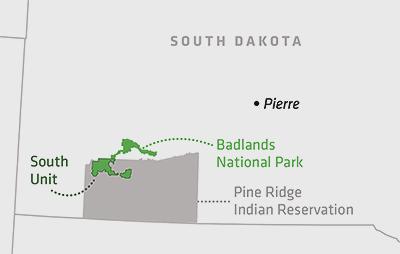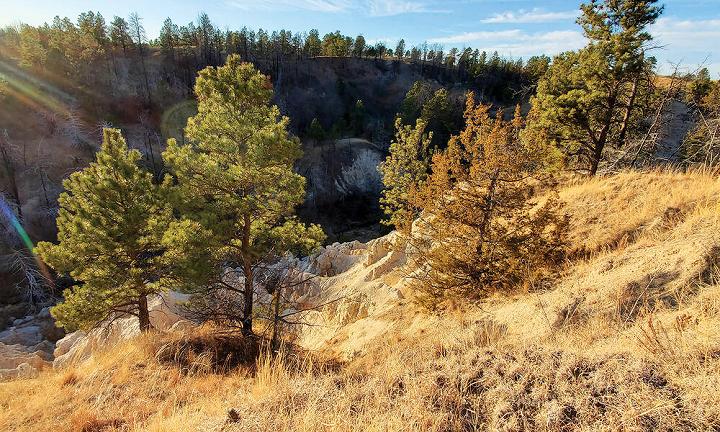 |
Canku Ota
|
 |
|
(Many Paths)
|
||
|
An Online Newsletter
Celebrating Native America
|
||
|
September 2021 - Volume
19 Number 9
|
||
|
|
||
|
OUR HOME, OUR STORY
|
||
|
by WORLD WILDLIFE MAGAZINE
|
||
|
FOUR MEMBERS OF THE OGLALA
LAKOTA NATION SHARE STORIES FROM THEIR LIVES
In September 2020, in the midst of the COVID-19 pandemic, WWF worked with Indigenous leaders and photographer Jason Houston to gather stories from Pine Ridge Reservation in South Dakota. Here, four members of the Oglala Lakota Nation share, through their own words and images, stories from their lives. Monica Terkildsen WWF Native Nations liaison and a member of the Oglala Lakota Nation. Monica facilitates Indigenous conservation efforts and works to bring the will of her people to the management of their land. I am of the grass, plants, and trees, the root nation that sways in the winds of the prairie of the Northern Great Plains, storing carbon and returning oxygen to the world above. I am of the soil, that holds the very footprints and knowledge of my ancestors and provides life and vision for me. I am Oglala Lakota, Indigenous to this land, to this space, and I want to share with you the story of this place.
Today, the land base of the Oglala Lakota Nation is roughly 2.7 million acres of pristine grasslands in southwestern South Dakota. Pine Ridge Reservation’s land base is the result of many acts that broke and forced together small pieces of Unci Maka, our Grandmother Earth. This is the place of the Wounded Knee Massacre, an attempt to end a way of life and annihilate our circle, our connections, and our homelands. But look at the lands, the beauty, the colors, and perspectives we share with you through the camera’s lens, to uplift our truths in the time of the pandemic. We, as a nation, stand strong and hold tight to our beliefs, protecting our people amidst new policies, shutdowns, virtual connections with inadequate infrastructure, sheltering in place, permitting, confusion, hunger, fear, loss with an inability to mourn, and movement stifled. Hope remains. Despite the circumstances, we share our story. I want to tell you about the Stronghold Unit, which many call the South Unit, 133,300 acres of tribally owned land within the boundaries of the Pine Ridge Reservation. You might know it as part of the Badlands National Park. This land was originally small allotments given to tribal members, generally 160 acres for a head of household and 80 acres for a single member. Of course, there was no justice in this land distribution process; how can one own and divide their grandmother? Then came WWII and the US needed a place for practice and training. What better than an Indian reservation? An aerial gunnery range was created through condemnation and eminent domain proceedings, forcibly taken from tribal members, again, and trashed for over 20 years through bombing, training, and target practice. Today there are many places where unexploded ordnance is exposed as the land erodes. After many years, tribal members were able to purchase lands back, except for the Stronghold Unit. In 1968, Congress wanted 133,300 acres to create the Badlands National Park. With it, Congress expanded National Park Service boundaries outside of the bombing range and drew management lines across individually allotted land, intruding and creating more emotional harm. Much of my work is an attempt to address that harm by seeking a way forward, with community members speaking clearly about their wants and needs, in a way that honors the land and our history here, and will be beneficial for us all. We’re aware of what’s been taken, of the harm that’s been done, and we’re looking forward. That’s why we established the Community Stronghold Working Group and are creating a Declaration of Priorities, with representatives from several of Pine Ridge’s districts, to make sure everyone is heard. With our photos, we hoped to capture this tragic story, to capture the beauty and the opportunities that our nation speaks about, and to share what we wish to pursue within this space. In the past, in the United States we Indigenous people didn’t have a voice in what happened to our land. Well, now we do have a voice. So rather than come from a place of oppression, we hope these pages reflect the truth: We are resilient, we have hope, and we have a voice. We seek healing and equity for the members of our nation, Unci Maka, and our connections to each other. And we choose to have a voice in future decisions about our land.
Nick Hernandez Founder of Makoce Agriculture, a nonprofit focused on regenerative food systems. Makoce is the Lakota word for homeland. Nick received his master’s degree in Lakota leadership from Oglala Lakota College. Here, he talks about going on a tour to review uses of the Stronghold Unit. The majority of the South Unit is in my district on Pine Ridge Reservation. A lot of tribal members drive by and through it daily to go into the city. Makosica is what it’s called—Badlands. A lot of this area is culturally and historically significant due to the relationship we have with the land as local Indigenous people. Everybody has a piece of history connected to this area, and it gets passed down generationally in our storytelling.
This was my first time visiting a lot of those places. The area is being re-reviewed for the reintroduction of buffalo and community use. It symbolizes our reintroduction to a species that we hold so high in our culture and in our life ways. The buffalo provided everything for us, generationally. When we talk about food and food systems, the buffalo is the all-encompassing food system that we are looking at reintegrating back into our Indigenous homelands. For me, it was special to experience that personally, but also to share that with my son. It was a different landscape from where we actually live, just 10 miles down the road. At four years old, kids are sponges, so they absorb a lot. Every time we drive past the Badlands, it’s always stuff like, “Hey, do you remember being over there? I remember going to Badlands.”
Andrea Two Bulls A self-taught painter, photographer, and artist advocate whose work sells across the country. Andrea worked at Singing Horse Trading Post until the pandemic closed down the tourist industry. I’m always just looking for beautiful things. When I was younger, I was everywhere. I’ve hiked every bit of this land, all back up in those hills. If I’m not hunting, then I’m hunting rocks. Because we grew up here and we’ve always lived out here, it baffles me why so many people pay money to come and see it. As you get older, you realize that it is ruggedly beautiful and it’s unique. It’s our backyard, but it’s beautiful. We need to protect it. We need to protect it for our kids, our grandkids.
We would like it left wild. This is where we hunt. This is where we live. We don’t want people coming here. Just leave this untouched. Leave it alone. The Park Service wanted to bring in a heritage center to these lands, to the Red Shirt Table area where I live. They wanted to bring more people. But we said, “No. This is where we hunt, where we live.” They wanted an equestrian center—there were all these ideas. We just said, “No. Don’t bring it here. Take it somewhere else. This is where we live.” It’s not the money that matters. It’s never going to be the money. It’s about the area, the wildness of it. You start bringing people in, there go the animal populations next.
Bamm Brewer Private buffalo rancher and founder of a company that processes bison and other wild game. He also founded the Native American Honor Ride, which commemorates cultural history, Crazy Horse, and all US veterans. I’m not the best historian—there are people amongst our tribe who are better—but I do my best with what I know anyway. The youth are the future of our nation. We try to teach them things that our ancestors would teach. These are five buffalo skulls that we use at our Sundance [Editor’s note: Sundance is a traditional Lakota summer ceremony that the US government had outlawed until the 1970s]. Sundance is very important to us: We didn’t do it this year because of the pandemic, but I pulled them out as a reflection of prayer, of a year away from our normal ways.
But then I see our buffalo herd with a full moon coming up and it was just a nice purple sky. It was just making it through the winter. When you’re able to look out on your own landscape and see buffalo there? It makes you feel like you’re doing something. It’s something that not all tribal members get to do. We’re really lucky to be able to have that scene at the house. I wish herd management was not as rugged—I wish the buffalo were a little more gentle. But it is what it is. Buffalo are wild, and we got to do what we got to do to get them. We’re always improving every year. I’m hoping that one day we’ll look back and say, “We used to do it that way, and now we have a gentler way.” I’m glad to be a part of this way of life. I hope our ancestors are proud of us. I know they are.
|
||||||||||||||
|
|
||
|
|
||
| Canku Ota is a free Newsletter celebrating Native America, its traditions and accomplishments . We do not provide subscriber or visitor names to anyone. Some articles presented in Canku Ota may contain copyright material. We have received appropriate permissions for republishing any articles. Material appearing here is distributed without profit or monetary gain to those who have expressed an interest. This is in accordance with Title 17 U.S.C. Section 107. | ||
|
Canku Ota is a copyright ©
2000 - 2021 of Vicki Williams Barry and Paul Barry.
|
||
 |
 |
|
|
The "Canku
Ota - A Newsletter Celebrating Native America" web site and
its design is the
|
||
|
Copyright ©
1999 - 2021 of Paul C. Barry.
|
||
|
All Rights Reserved.
|
||





